The Lipscomb family

Iris ‘Duckling‘
If, like us, you are keen on flowers and plants, what a joy it is to be able to share the passion. It is particularly rewarding when the younger generation becomes enthused too. Often children and young people will shy away from things that their parents are interested in, but for one family, this was not the case.
Last year Olga Wells gave us an iris called ‘Duckling’. She didn’t say anything else about it, except that it was an old iris, but a letter we received in 2017 showed how Olga had come by this iris.
Sue had given a talk to the Kent Group of the Hardy Plant Society and David Clark had been in the audience. He was living at Platt in Sevenoaks and had been looking back in his garden notebooks and researching Iris ‘Duckling’. He told Sue that when he had opened his garden at Fairseat Rectory for the National Garden Scheme in 1987, John Hawkins, an iris lover and member of the Kent Iris Group gave him some rhizomes of the iris. David and his wife retired to Kimmeridge in Dorset and took the iris with them, but returned to Kent in 2004. In 2011 they joined an excursion to South Africa in the spring organised by Colin Moat and there David met Olga Wells. A few years later he gave a piece of ‘Duckling’ to Olga and Olga told David that the iris had been introduced in 1939 and Olga looked after the iris until she gave it to us.
Upon looking up Iris ‘Duckling’ on the wiki iris website, it was confirmed that it had indeed been introduced in 1939 by John Kenneth Lipscomb. John showed ‘Duckling’ in Class 24 at the British Iris Society Iris Show in 1938 along with the other new cultivars including ‘Kenneth’, ‘Sunlit Water’ and ‘Ethel’. So who was John Lipscomb and what relation was he to the other Lipscomb, also referred to in the British Iris Society Yearbook?
On checking the past Yearbooks of the British Iris Society an Ethel Lipscomb was mentioned. She had become a member of the British Iris Society in 1930. So were there other members of the family who were keen horticulturalists as welI? We had to find out.
Ethel was married to Frederick Bell Lipscomb who died tragically young aged 46 on 27th September 1899, following a fall from his bicycle. He was vicar at Flitwick at the time and there is a stained glass window dedicated to him in the church. The window depicts Christ as the Sower and Shepherd, fragments of medieval glass were incorporated in to the window. Ethel was now widowed and was left with five young children the eldest of whom was 12, the youngest and the only daughter just one.
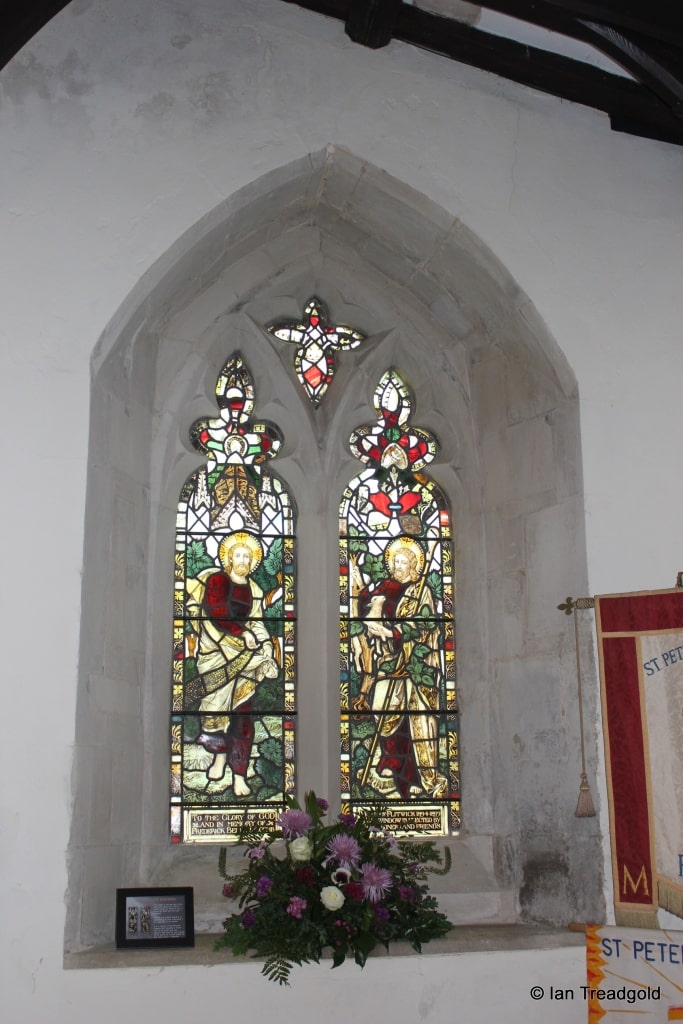
Stained glass window in Flitwick Church
The eldest son was called Frederick Martin and he became a doctor and served in India and Mesopotamia in the First World War returning to England in 1921. On his return he qualified as a specialist in medicine and returned to India in 1924. Apart from short breaks in England he remained practising in India until 1941. During World War II he was consultant physician to the Forces in Persia and Iraq and whilst serving in 1944-45 in North West Europe he helped in relief work at Belsen concentration camp.
Frederick Martin was unusual as he was particularly interested in two unrelated areas of medicine, geriatrics and tropical diseases. It was the two years after he qualified when he became interested in the problems and difficulties of managing degenerative diseases in the elderly in their homes. Further study from 1929-32 resulted in him publishing in 1932 the textbook Diseases of Old Age.
After his retirement from active duties in the Army he was reemployed as physician and surgeon at the Royal Hospital, Chelsea from 1949 to his final retirement in 1956. His grave, quiet, unhurried manner made him the confidant and friend of those old warriors who were his patients. Frederick Martin became a Brigadier and was awarded an OBE in 1945.
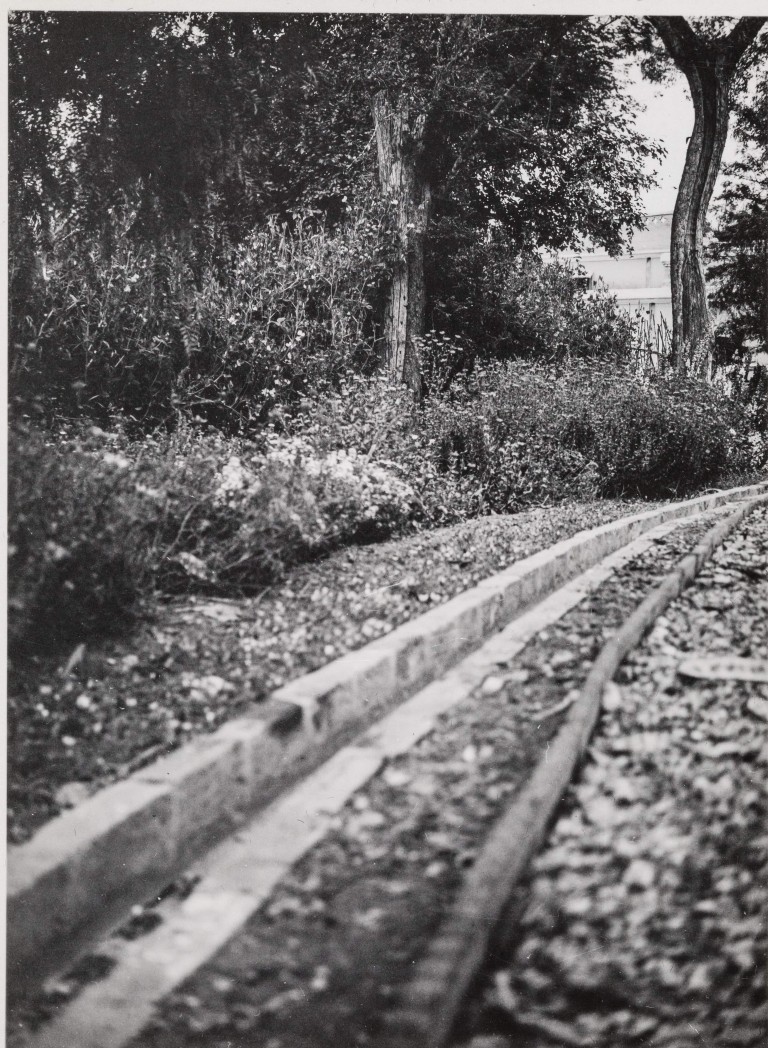
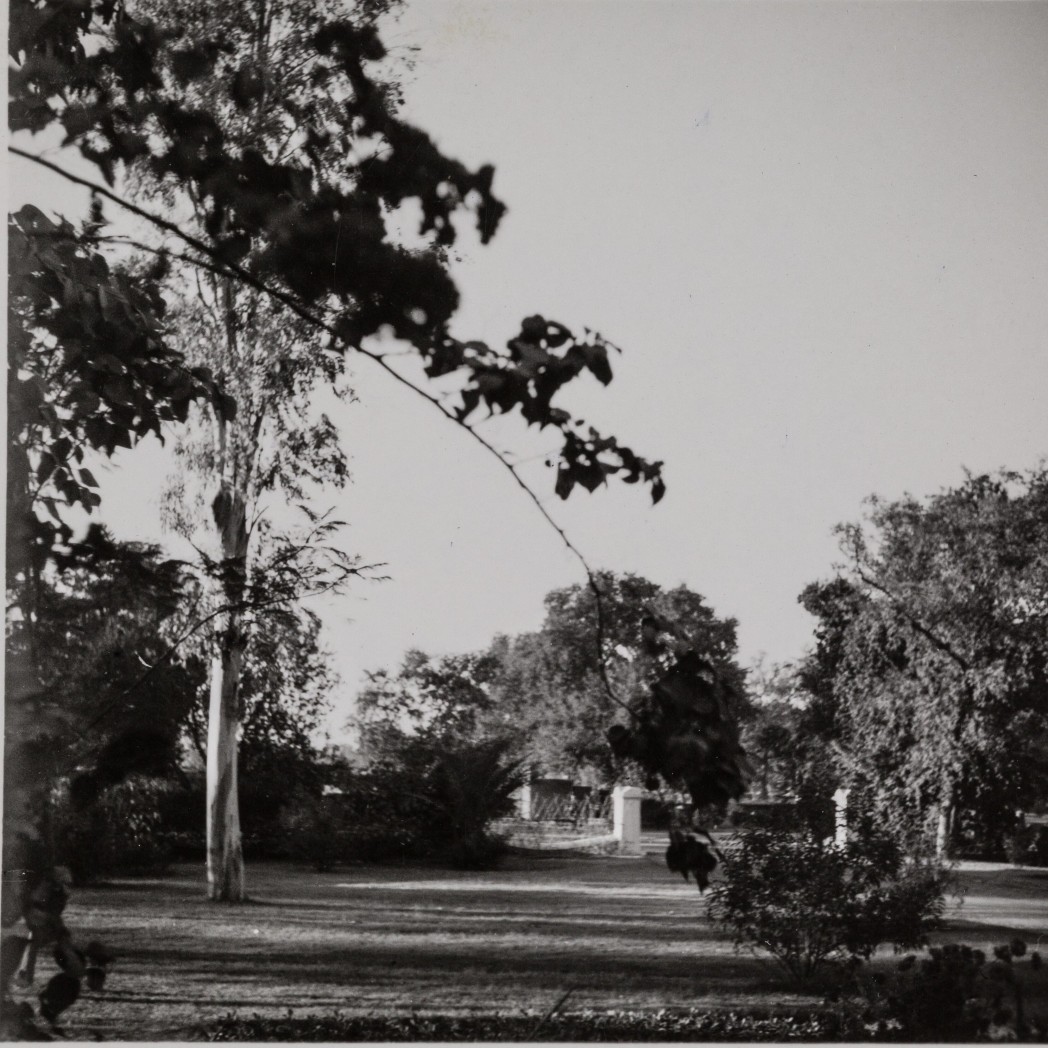
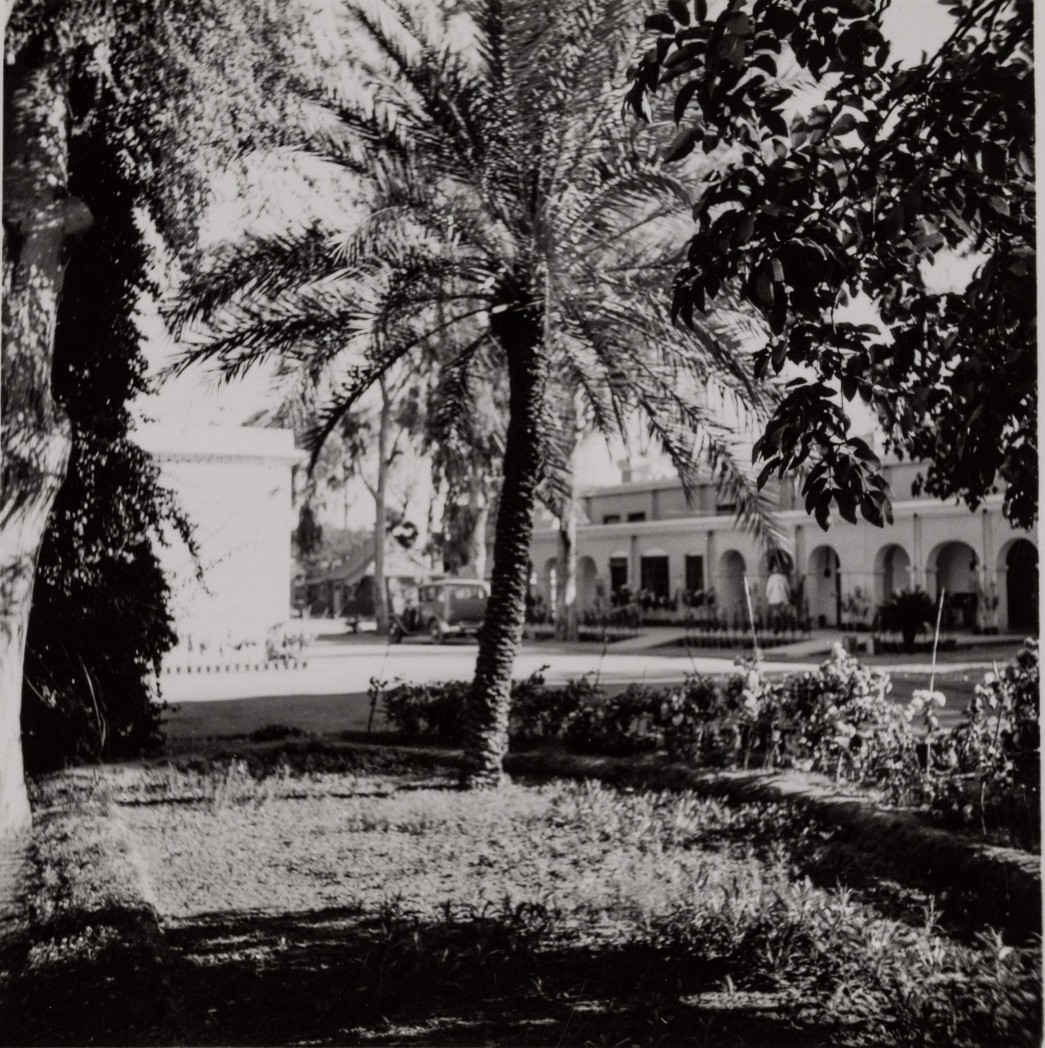
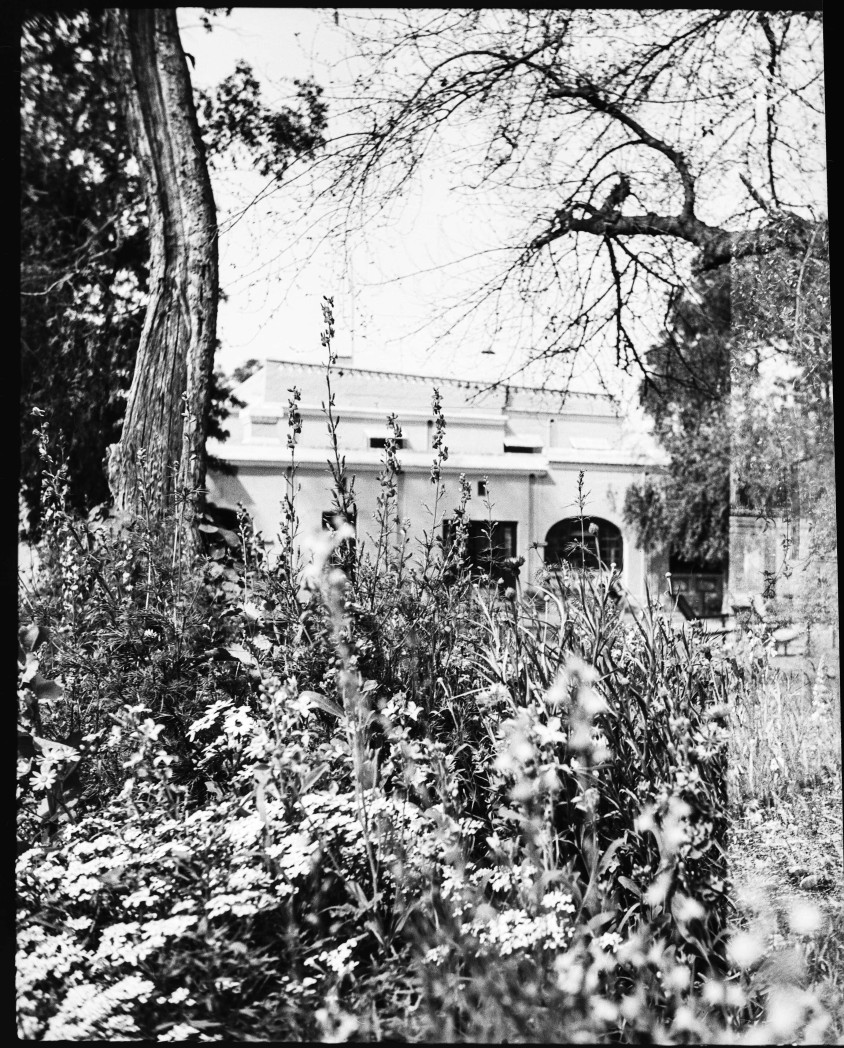
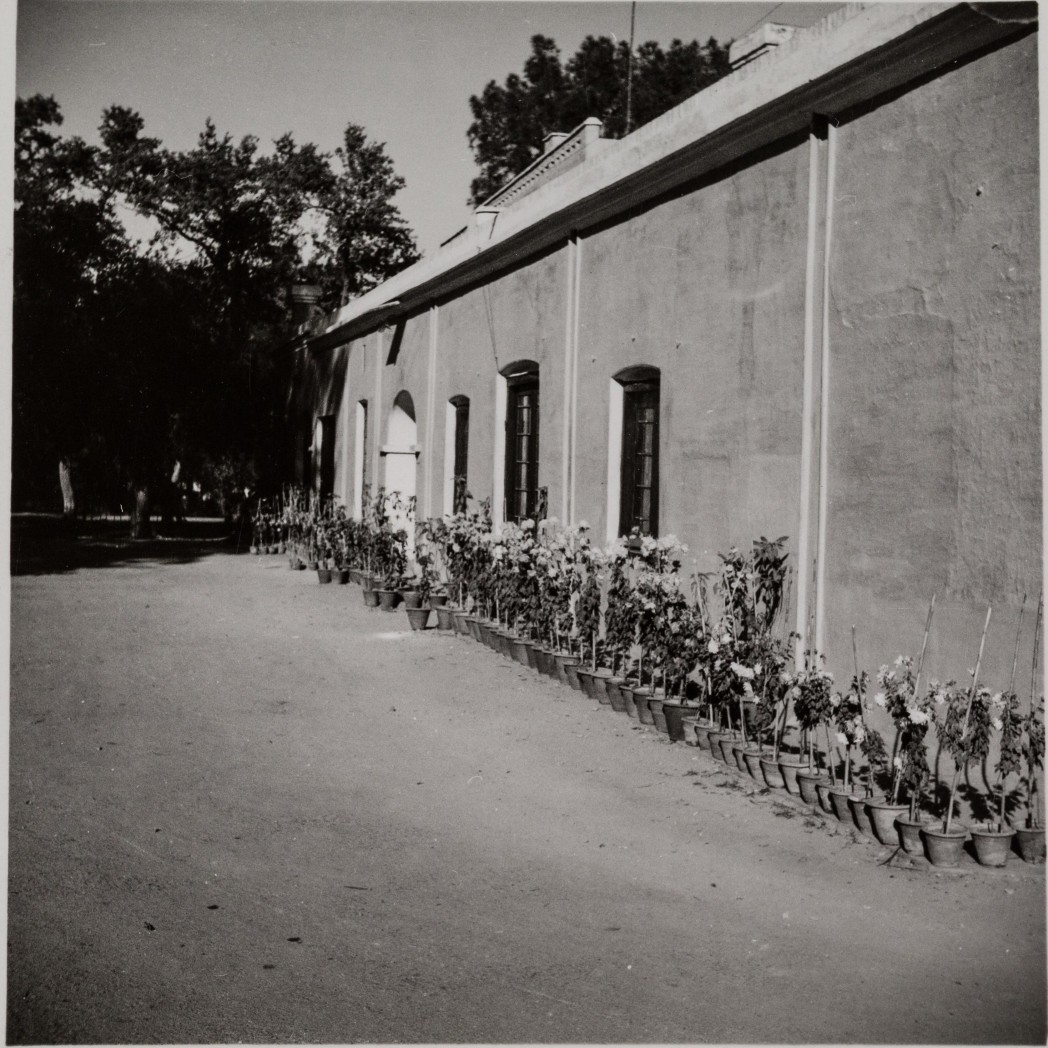 As you can see from these photographs taken by Martin Lipscomb (as he was known by his family) not only did he take pictures of buildings but also the plants that surrounded him in India.
As you can see from these photographs taken by Martin Lipscomb (as he was known by his family) not only did he take pictures of buildings but also the plants that surrounded him in India.
Royal Army Medical Corps Muniments Collection holds photographs and memorabilia from Bridgadier Lipscomb. The photographs are from his time in India based at Rawlpindi. (see links below)
Frederick Martin’s only son was John Christopher de Bohun Lipscomb (1921-2002). He was in charge of a Unilever palm oil estate at Yaligimba in the Congo; here he hosted the writer Graham Greene when he visited the country in the 1950s. John Lipscomb is the grandfather of the historian Suzannah Lipscomb.
But it is the second son of Ethel and Frederick Bell, Lancelot, who showed a great interest in plants and had a particularly interesting horticultural pedigree. Lancelot did not follow his brother in to either medicine or the military, but instead sailed to Central America in 1910, working in Panama, clearing bush so that cocoa and rubber plantations could be planted.
In searching the internet, I found this beautiful photograph of a flower, attributed to Lancelot. The picture was held by the Library at the Royal Botanical Gardens, Kew, London and so a trip to Kew was a necessity.
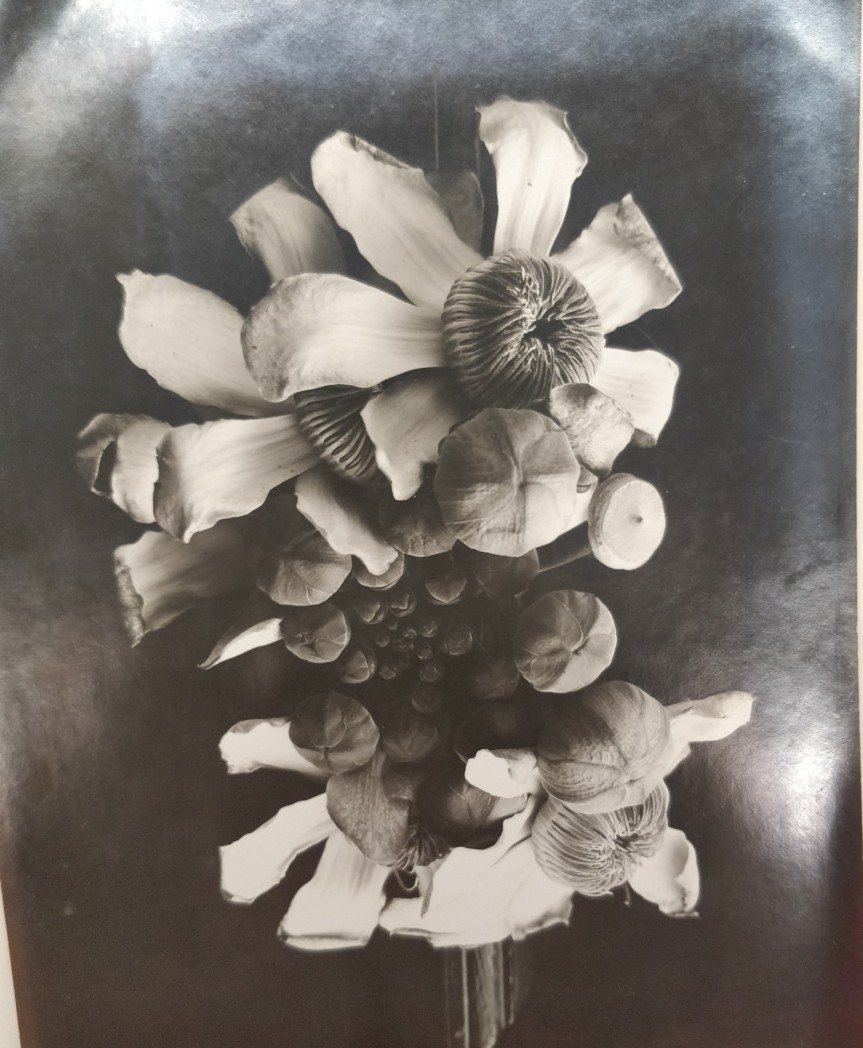
Lancelot may have been interested in a variety of plants before he set sail for Panama, but we shall never know that for certain. What I did find at Kew was that Lancelot took a great interest in the local flora in Panama, and in particular orchids. A small archive of correspondence, notes, drawings and photos had been donated to Kew by his niece PM Lipscomb in 1978.
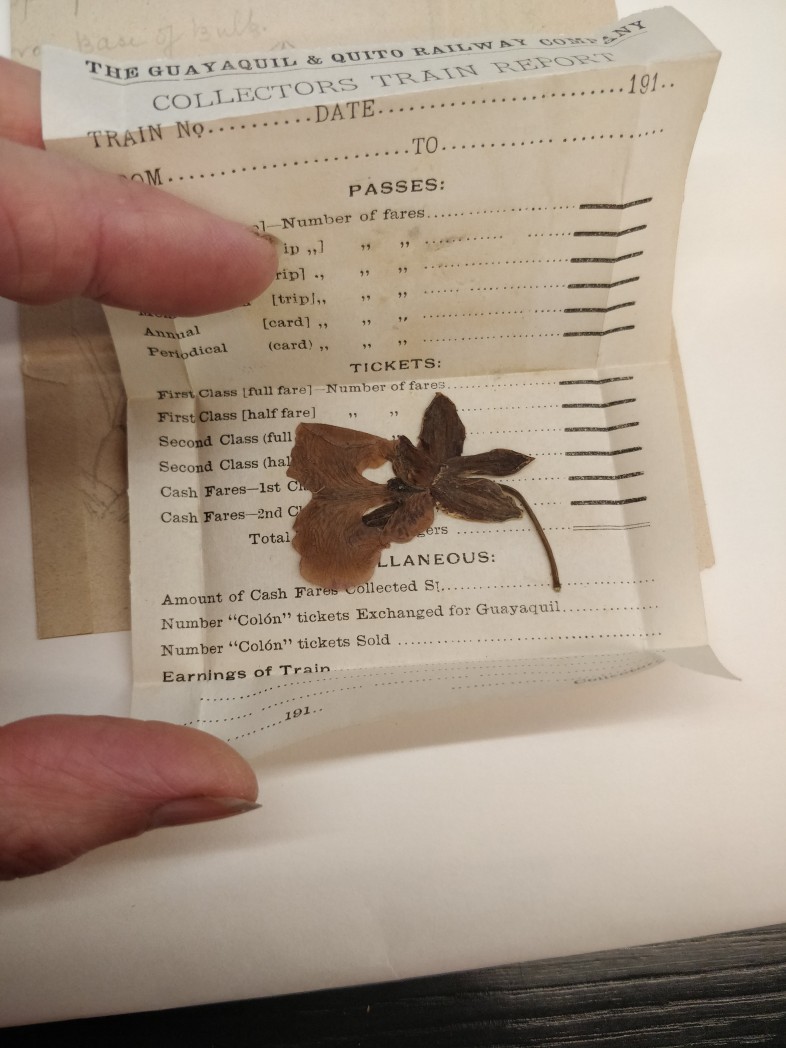
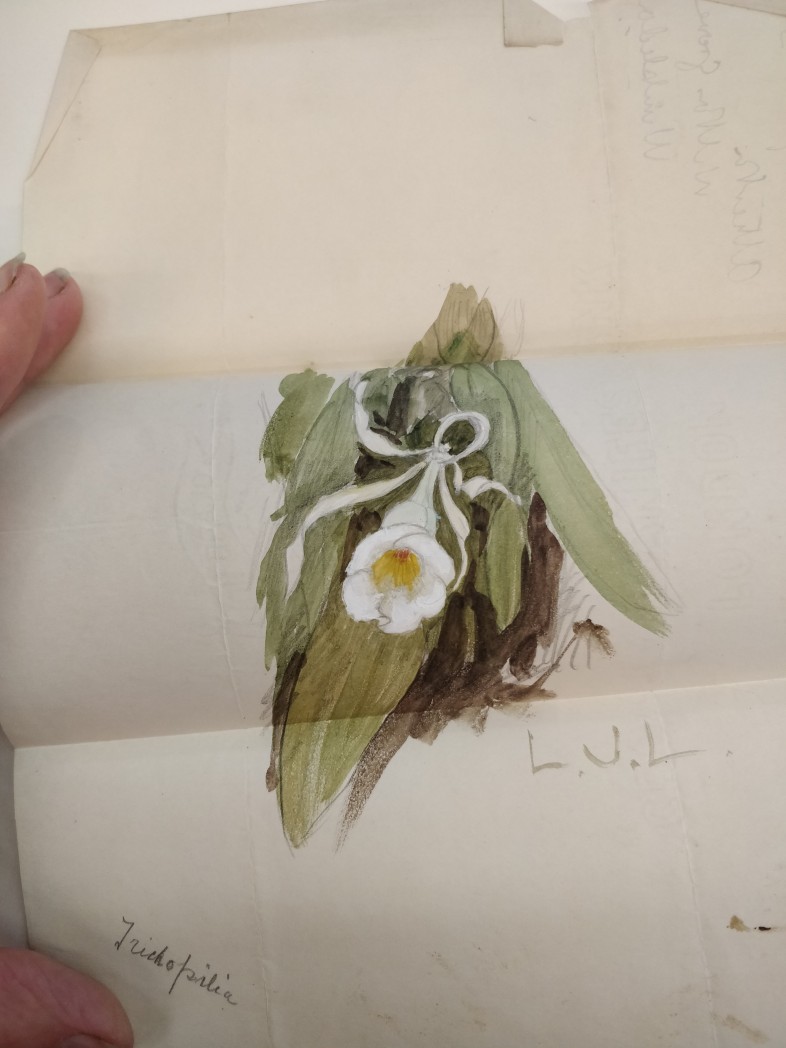
Lancelot sent back to his mother in England a number of orchids that he had collected in Panama. He was given some by a fellow orchid hunter and was told that they were some of the best to be found. A number he believed were unknown and so Ethel Lipscomb sent specimens to Kew Gardens to be identified.
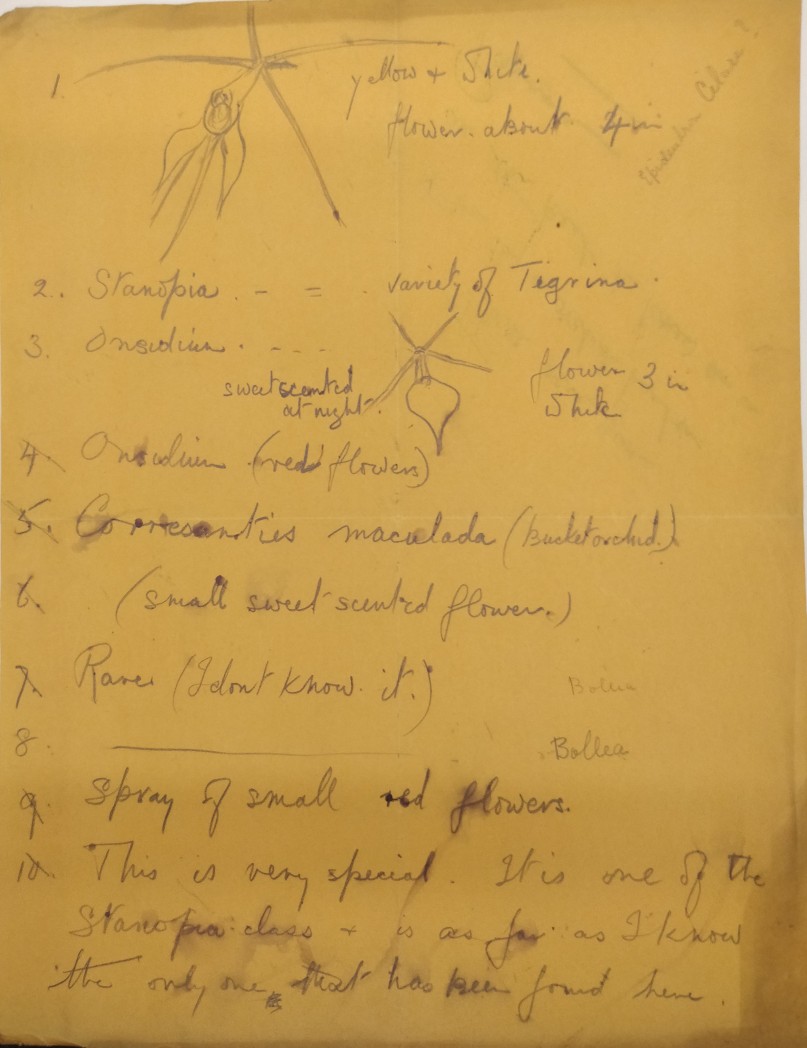
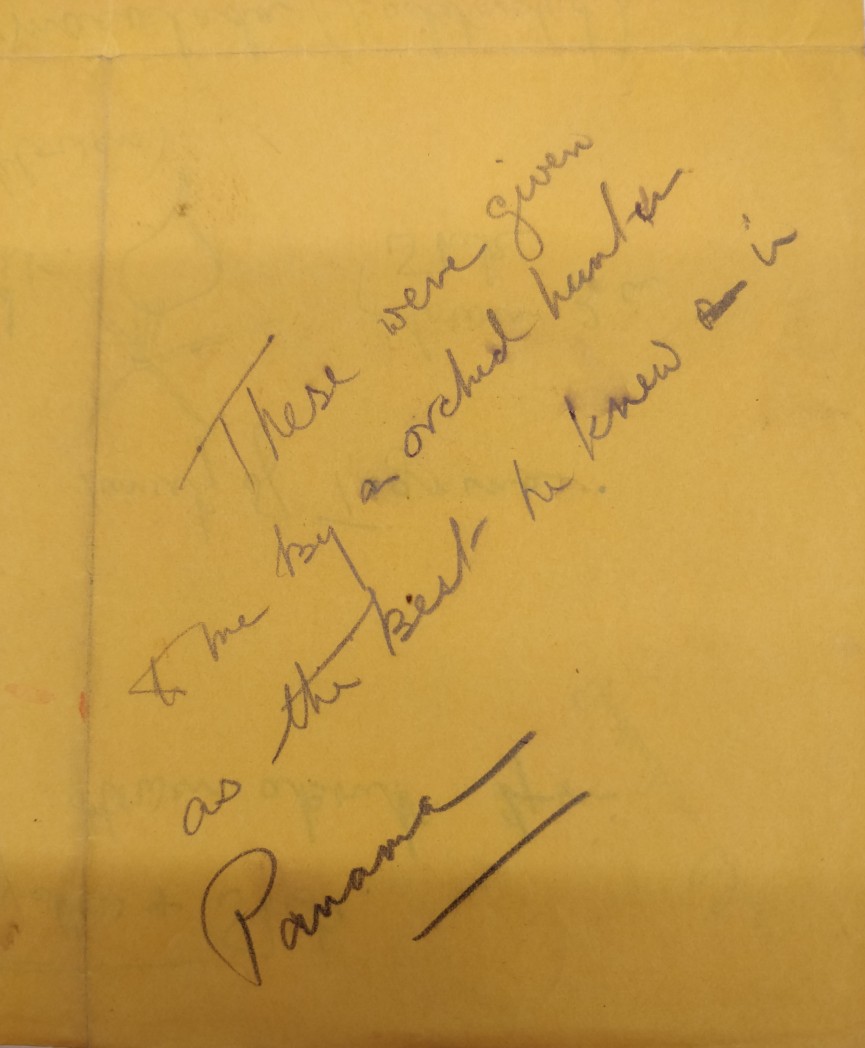
One orchid in particular had not been identified before and Kew named it Chondrorhyncha lipscombiae as Lancelot had discovered it. It was written up in the Orchid Review and Ethel Lipscomb requested a copy of the Review.
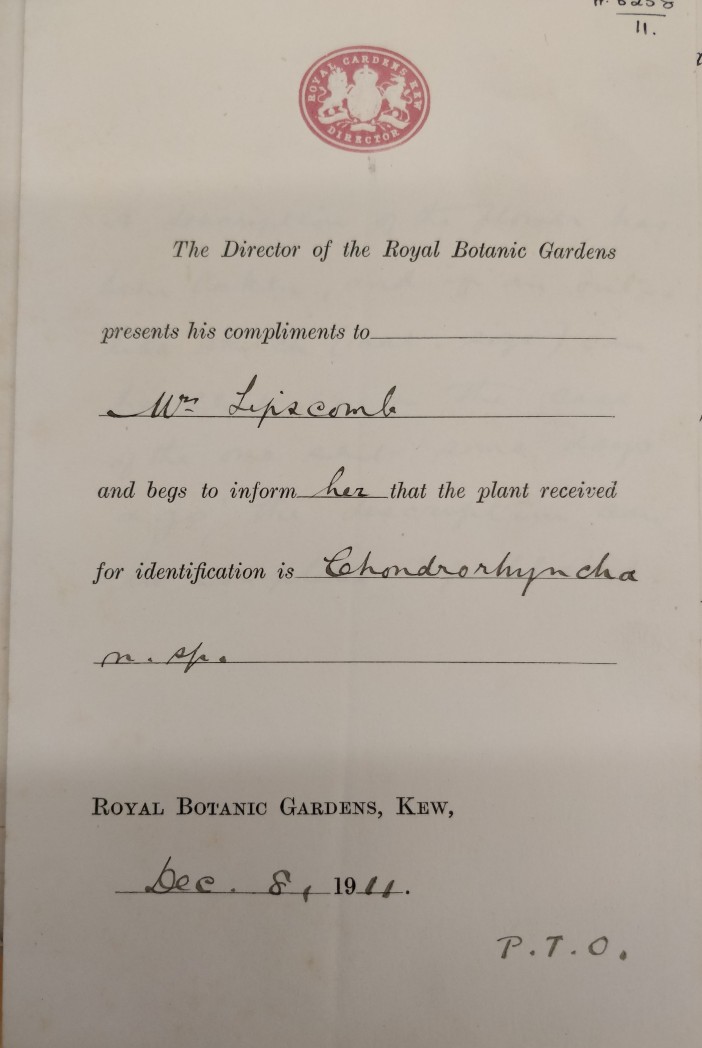
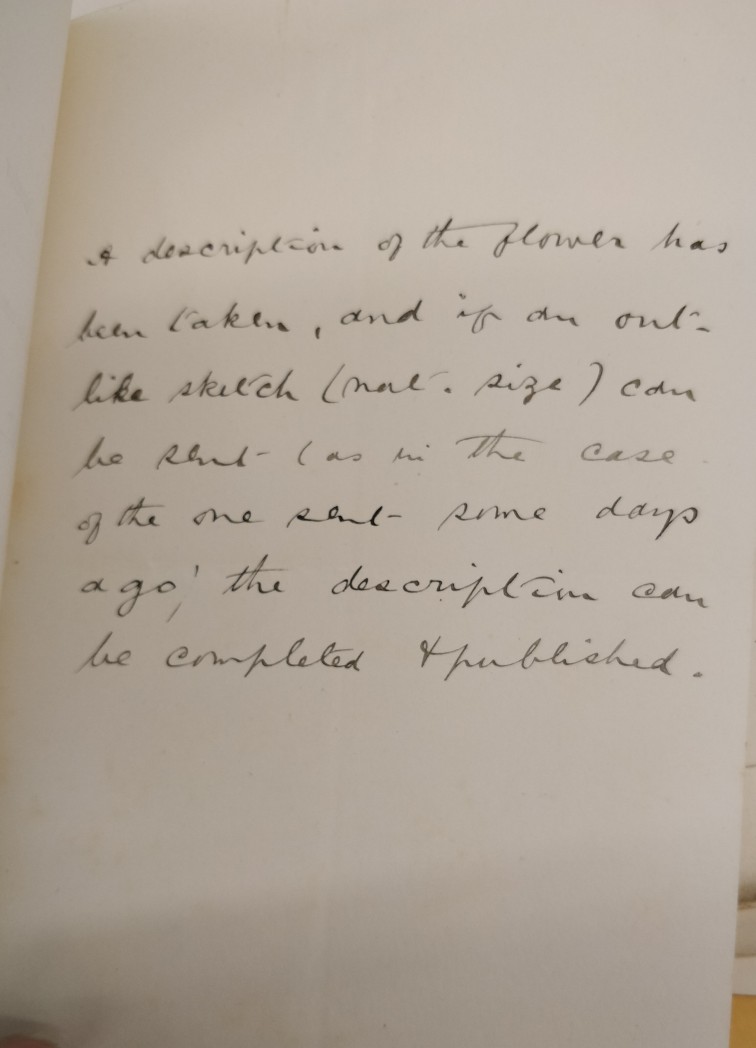
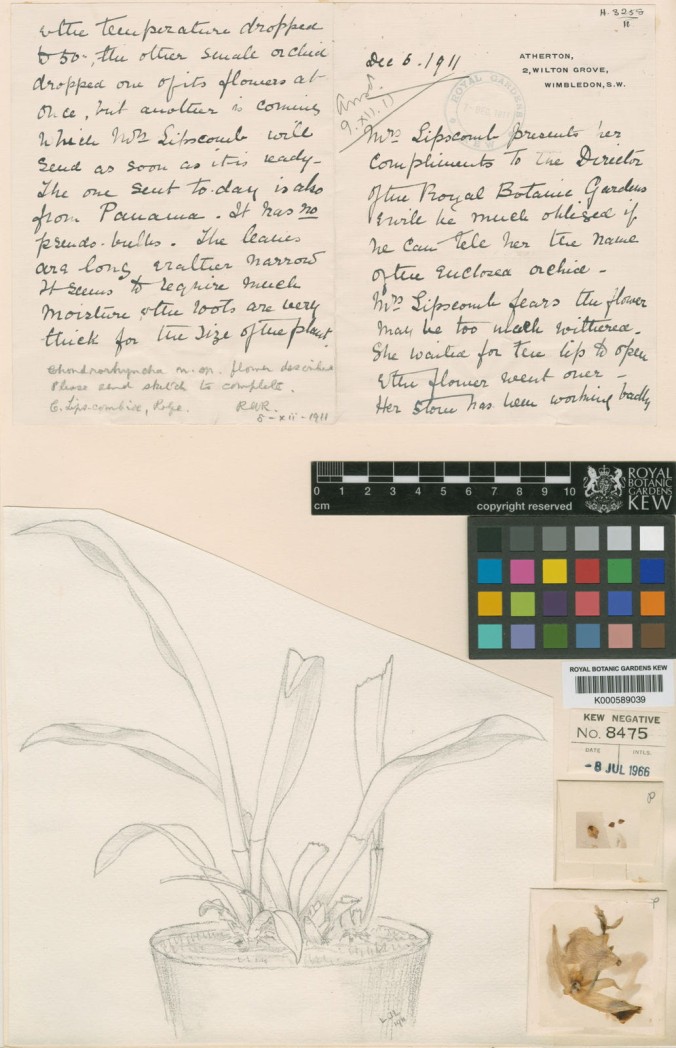
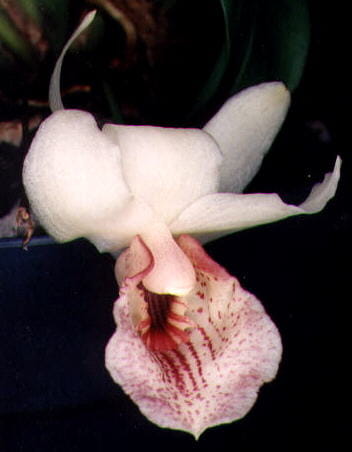
Chondrorhyncha lipscombiae herbarium specimen from RBG Kew. It is now known as Warczewiczella Lipscombiae
A Mr JC Harvey, a planter and Consulting Tropical Agriculturist in Mexico wrote to Ethel Lipscomb in early 1911, having read a copy of the Orchid Review. He was interested in tracking down the orchid Catasetum Scurva, an orchid that Lancelot had managed to collect. Mr Harvey sent pictures to Ethel of his own collection of orchids in Mexico.
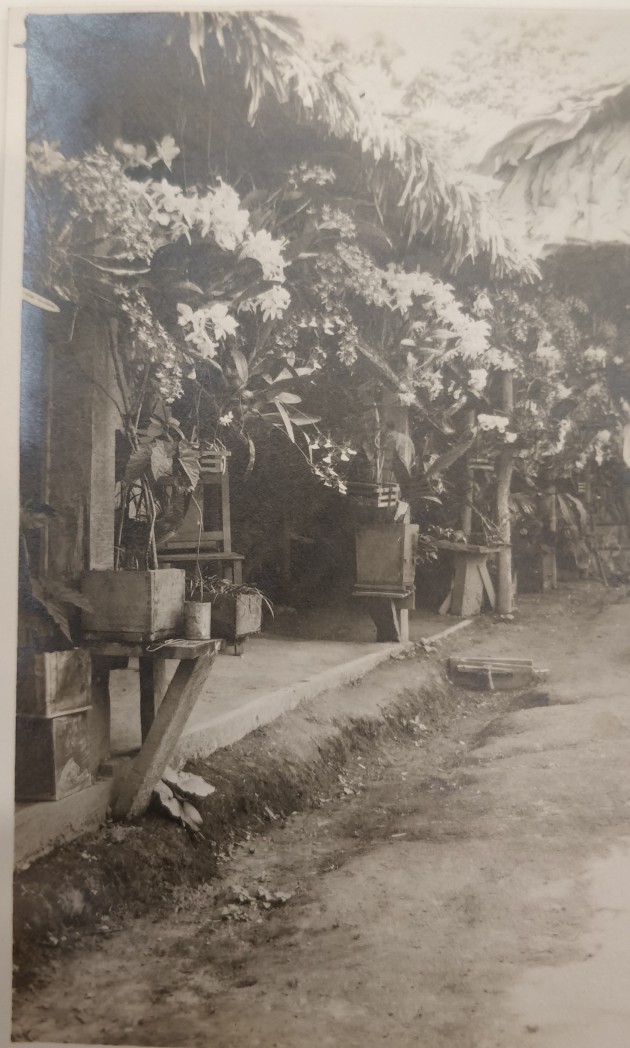
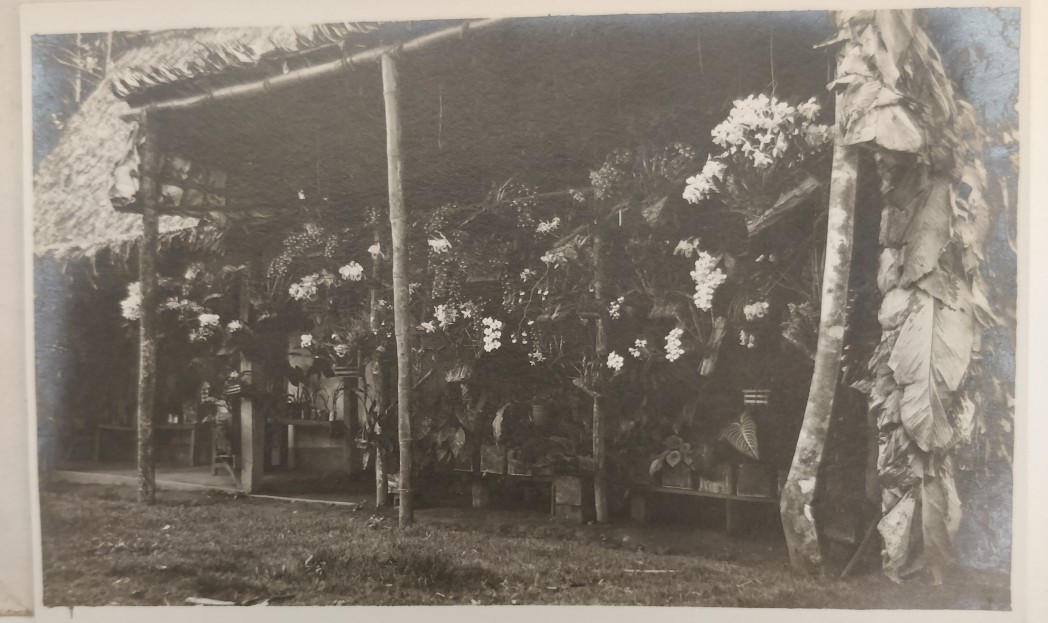
In one of his letters home Lancelot describes Catasetum Scurva
…’The Catasetum Scurva is the sweetest smelling flower I know, almost too powerfull (sic). Everywhere within 100 yds of the plant when it was in flower smelt like a rose garden in full bloom on a hot June day. If it should happen not to be Scurva but a variety or new kind I want if possible to have it named Catasetum Gladysii.’……..
In the same letter he mentions his Chondrorhyncha are flowering and says…..
….‘I find the purple colouring of the lip is entirely dependent on the sunshine and light received by each individual flower. Those growing and opening in full light taking the richer colours.’……..
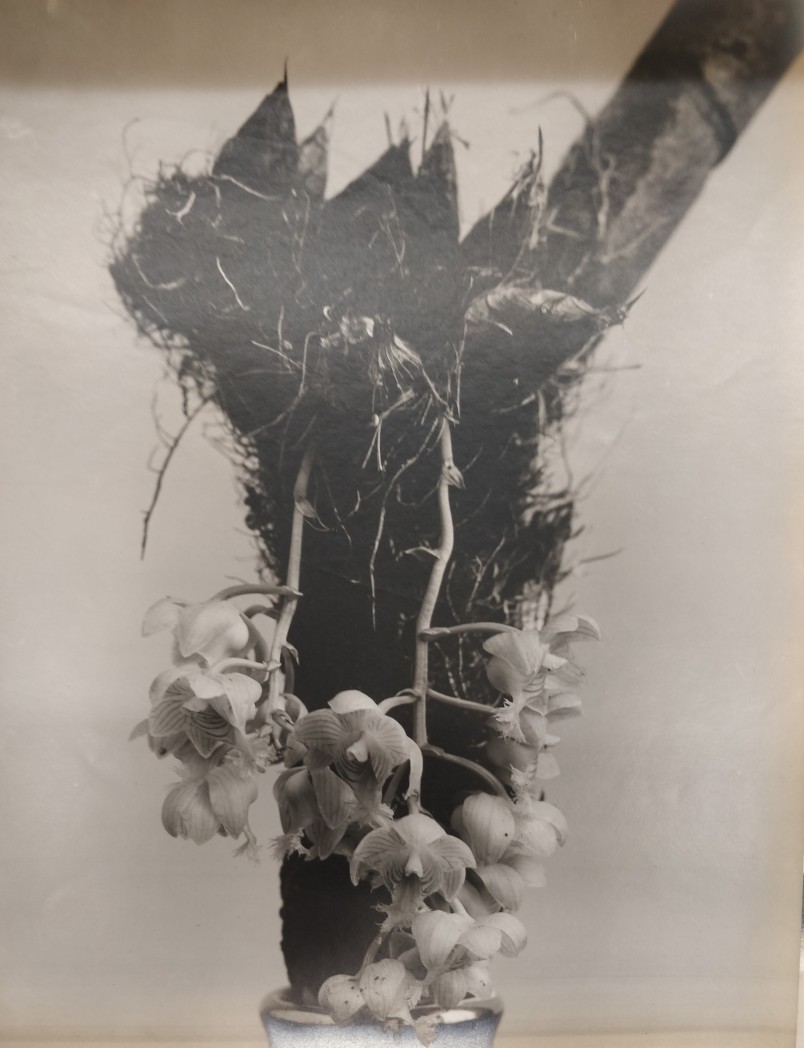 Catasetum Scurva
Catasetum Scurva
Lancelot was obviously confident in his mother’s horticultural skills. Looking at the correspondence he did indicate where he had found the orchids so that his mother could replicate their growing conditions. She seems to have been successful, because one note says the date when the plant was collected and that it flowered the following year at her house in Wimbledon in 1911.
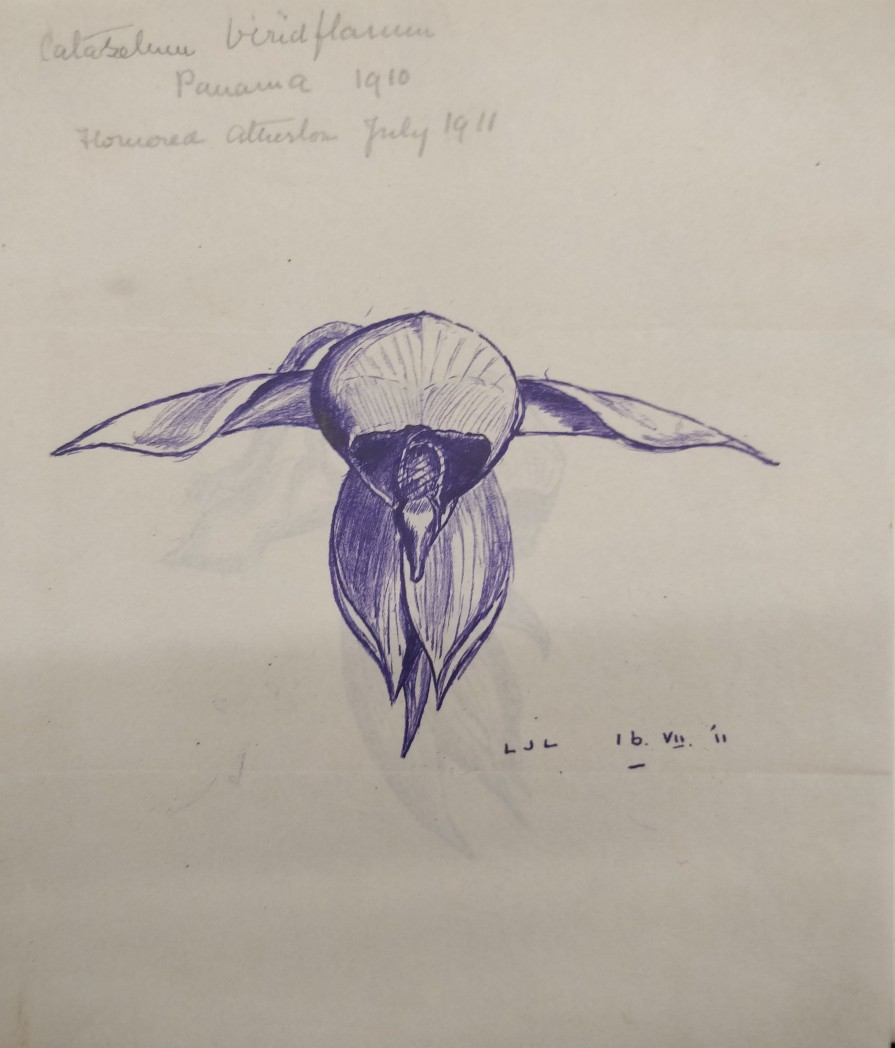
Ethel ordered her own orchids in 1911 from the renowned Orchid nursery Sander and Sons. She had Bulbophyllum umbellatum, an orchid from Asia and Laeliocattleya Martinetti, a hybrid from two Central and South American orchids.
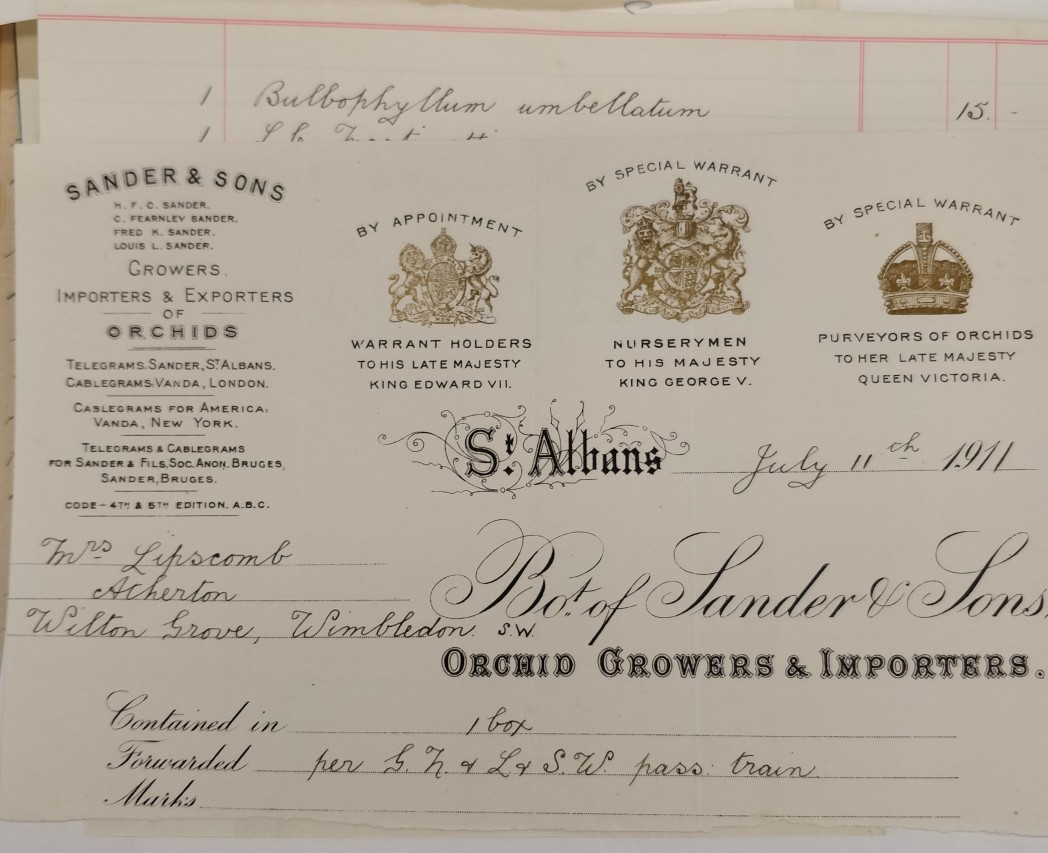
Lancelot continued to work in Central and South America as a planter and married Verna Sawtelle, an American. Lancelot is listed as sailing from Liverpool to New York in 1922 and by this time he is a motor engineer. He settled permanently in America and had one daughter.
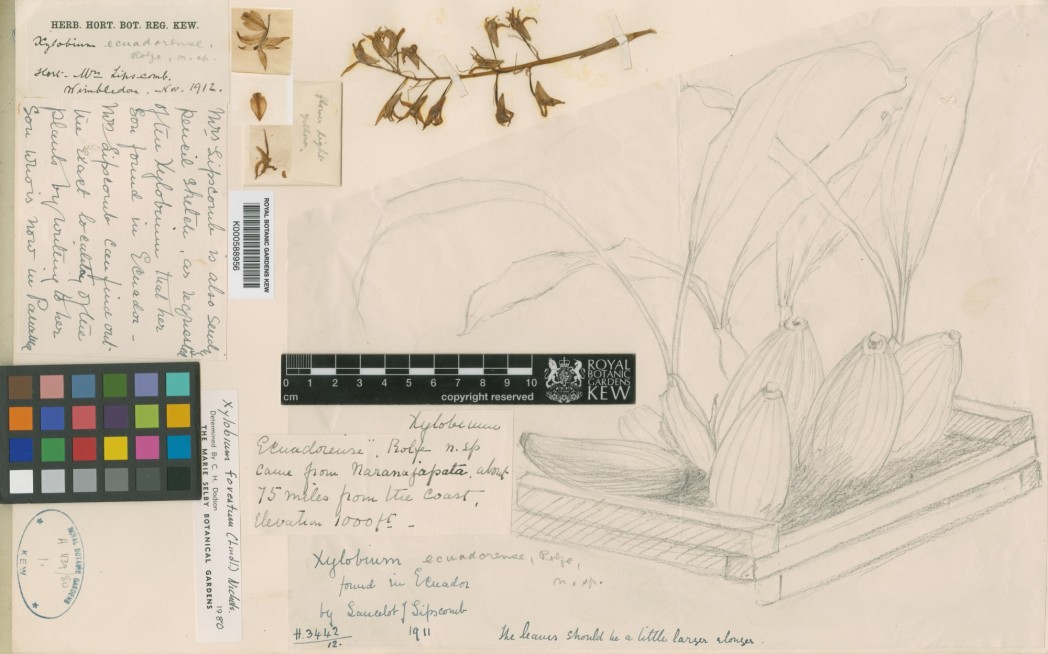
Herbarium specimen held at the Royal Botanic Gardens Kew of an orchid found by Lancelot Lipscomb.
And what about his collection of orchids that he sent to his mother. Well amongst the correspondence is a letter from Ethel Lipscomb to Sir David Prain, the Curator of Kew offering what remained of her orchid collection to Kew Gardens. It was written on 1st November 1915……
‘To the Director of the Royal Botanic Gardens, Kew,
Dear Sir,
‘Owing to the war I am obliged to give up my small orchid house. In it are one or two orchids which have proved to be new when they were sent to you to be named.
My son, Lancelot J Lipscomb, who found them, wishes me to send any of them to you for the Royal Botanic Gardens, if you wish to have them.
I enclose a list.
I am afraid they are not in so robust a condition as they were this time last year, I have been away from home so much owing to all my sons, but one, who is medically unfit, having joined the army – I have always looked after the orchids entirely myself. But if you care to have any of them they would of course recover more quickly than elsewhere. I don’t think there is very much the matter, but the house has been allowed to get dry and too cold. If I pack them in a box with wood wool and send them by parcels delivery from Victoria Station, when I come up to town. I think they should travel safely – none are in flower.
My son says Chondrorhyncha lipscombiae Rolfe is very difficult to keep for many years in Panama. I have one young plant only (and a tiny piece of one) but there are several shoots. Any I have put on the list I could send to you.
Yours truly
Ethel J Lipscomb’
Note written on letter ‘Accepted. Man will be sent to meet train when hearing from Mrs L’.
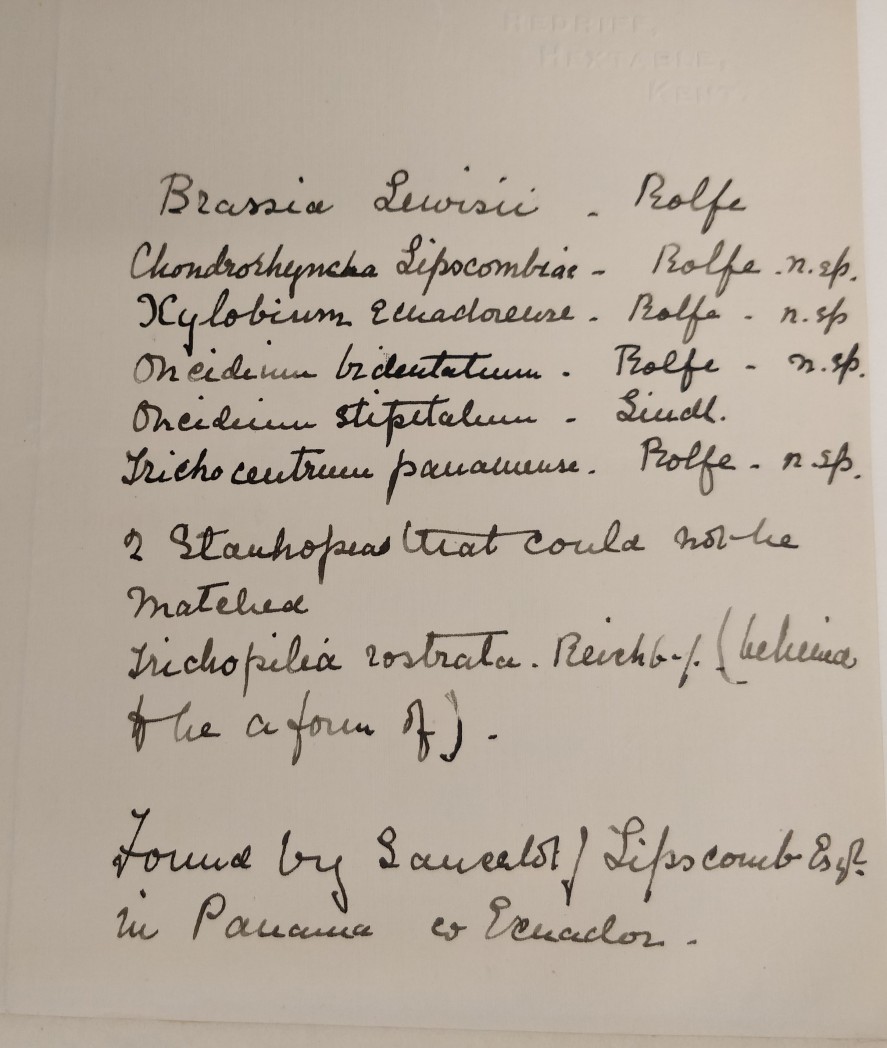 The list of orchids Mrs Lipscomb is going to donate to Kew.
The list of orchids Mrs Lipscomb is going to donate to Kew.
The orchids were delivered on 16th November and in her letter on 9th November, Ethel Lipscomb gave a little more detail of Lancelot’s travels. Ethel included one more orchid that Lancelot had found in Ecuador. It hadn’t flowered. By 1915 Lancelot was in British Honduras, but Ethel said she could find out where it was found,……
….‘whether it was in the mountains or in the valley. Nearer Guayagil, as it was one he sent home by post, thinking it to be a good one, instead of sending it with the others in a case. He was working on the Guayagil and Quinto Railway for a year, and afterwards travelled by himself, with a pony, through the forests to the coast some bit north of Guayaquil and also on the Oriental Mountain which divide Ecuador and Brazil, so that the orchids came from different parts of Ecuador – unfortunately many he sent home perished for they took over two months to come.
In Panama he was on the high ground on the Eastern side of the canal near Las Cascadas, but he sent Ch. Lipscombiae from Bohio also from ground which is now submerged by the new lake formed by the canal and the rivers.
I am
Yours truly
Ethel J Lipscomb’
So during the war Ethel had moved from Wimbledon to Hextable in Kent. She gave up her orchid collection in 1915, but as we know, she fell in love with another flower, the iris, and began growing and hybridising them.
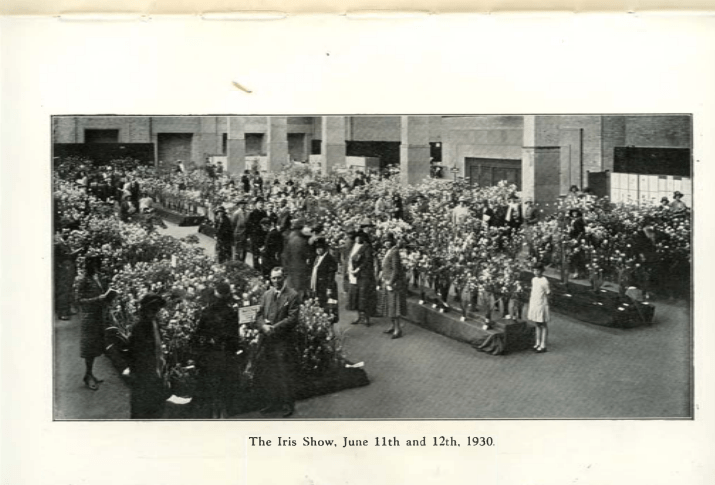
Ethel began showing irises in at the 1930 British Iris Society Shoe and in 1935 she won numerous classes and exhibited in Class 43 three varieties of unnamed seedlings. She was praised for her spikes of ‘Apollo‘ and ‘Cardinal‘. In 1936 Ethel won the Rainbow Challenge Bowl, for showing a number of iris in Division 2 of the show. In 1937 she showed ‘Kenneth’, ‘Red Egon‘ and ‘Bradminster‘ all her own seedlings and won a Bronze Medal. She also showed ‘Alice Harding‘ and ‘Lyra‘.
But it was JK (John Kenneth) Lipscomb who took up the baton of showing irises and in 1938 he entered ‘Kenneth‘, ‘Sunlit Water‘, ‘Ethel‘ and ‘Duckling‘ in Class 24 of the British Iris Society Show.
The 1939 register lists John and his sister, Enid living with their mother, who is incapacitated at Hextable, John is registered as a secretary and working full time as a warden, doing his bit in World War II. In the First World War John had joined the Tanks Corps, a new division of the army, and he rose to become a captain.
Whilst John obviously was interested in irises, he had another passion……Ducks and Geese. He and H Howes had written an article in the 1934 Yearbook of Agriculture (British Ministry of Agriculture and Fisheries). The article illustrated methods for successful breeding, feeding, management and marketing of ducks and geese and their by-products. In 1936 he was registered as the contact for the British Duck Keepers Association in International Review of Poultry Science. So this is where the name ‘Duckling’ came from for his iris!!
John was obviously very involved in duck breeding, but that did not stop him joining the Kent Iris Group when it was set up in 1946.
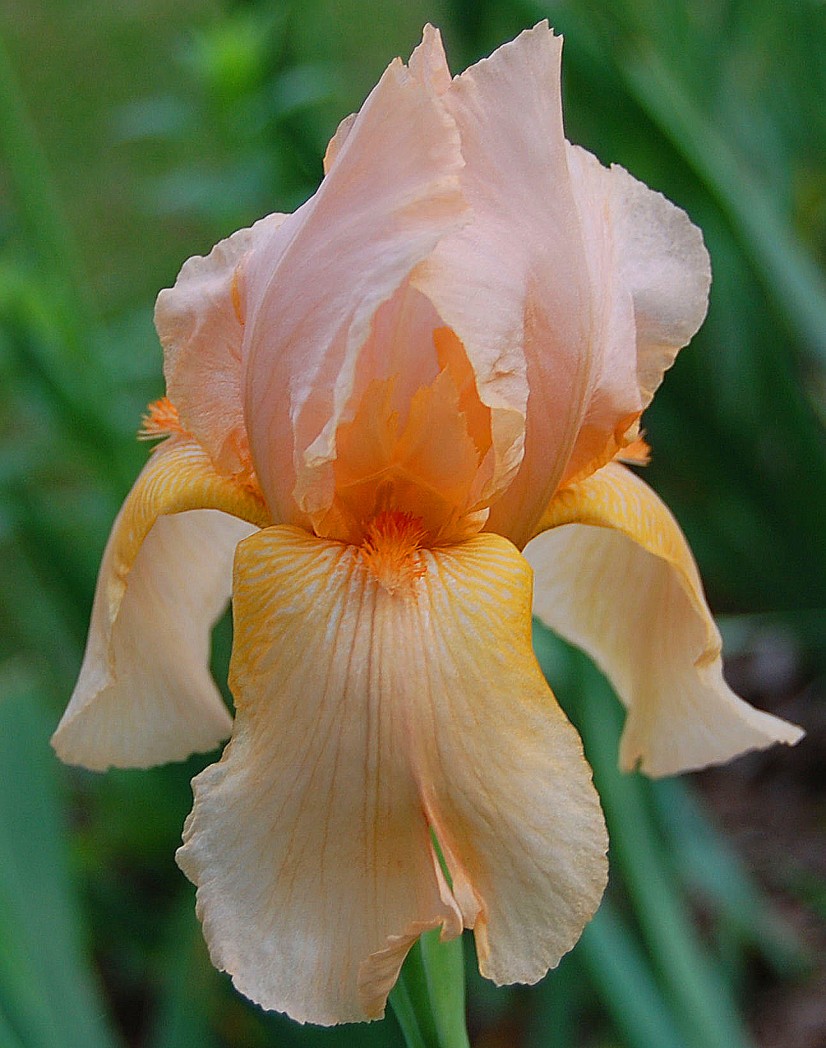 ‘Strathmore‘ was launched at the RHS Chelsea Flower Show in 1948. It was bred by Sir Cedric Morris. It had been named by Queen Elizabeth, later HRH Queen Elizabeth the Queen Mother
‘Strathmore‘ was launched at the RHS Chelsea Flower Show in 1948. It was bred by Sir Cedric Morris. It had been named by Queen Elizabeth, later HRH Queen Elizabeth the Queen Mother
In May 1948 Captain Lipscomb was one of a few Kent members to visit Sir Cedric Morris’s garden at Benton End. The trip was described by Miss Norman in the Kent Group book as follows:
‘The first visit of the season, that to Sir Cedric Morris’s garden at Benton End, was undertaken by Captain Lipscomb, Mr Birrell and myself (your editor and three other Members having fallen by the wayside). The train was hot and crowded and we were very glad to get to Ipswich and be on our way to the open Country. On our arrival Sir Cedric congratulated us on getting there when the iris were just at their best, and when we caught sight of them all in bloom on the sun-drenched slope of this garden, we knew we were indeed fortunate.
‘Plicatas without number displayed their grace and colour for our delectation. Plicatas spotted, etched, stitched, sanded and feathered, with light blue, dark blue, mulberry, red, tan, pink, lemon and cinnamon. Plicatas of delicate sweet pea shades and plicatas dusky, tawny and glowing like honey. BENTON PERSEPHONE of a lily-like whiteness and grace, BENTON HADLEIGH, copper yellow with amber falls, BENTON ASPHODEL, one of the many citron yellows having a white blaze on the falls, BENTON AURORA (looking very like the American ROYAL COACH, raised by Sass), a daffodil yellow heavily stitched with tan, BENTON OLIVE, to which one kept returning to have another look, having oyster standards with a greenish cast and falls the same but with a faint blue blaze; these are just one or two taken at random. Our greatest thrill, I think, was when we saw a huge clump of EDWARD OF WINDSOR numbering 60 spikes in full flower, showing most decidedly pink against a red brick wall.
The new flamingo pink seedlings were fascinating (a day or so later we felt rather proud to think we had seen STRATHMORE in its nursery bed before it appeared in public). Sir Cedric also drew our attention to the American MELITZA and ISABELLINA, which, he said, had played a large part in the production of his vermilion beard seedlings.
Along a side border was a rather exotic array of the Mohr strain iris, WILLIAM MOHR, MOHRSON, GRACE MOHR, ORMOHR AND ELMOHR in their varying shades of amethyst and plum purple. Among the many iris species in flower at that time in outlying borders, iris Aurantiaca was singularly attractive with short slender stem and huge golden bronze bearded flower.
The day passed all too swiftly, assisted by a very pleasant break at midday during which we had lunch in the cool refectory and enjoyed a short interlude with the very decorative Siamese cats. Too soon our steps had to be turned homeward, so with backward glances at the garden still shimmering in the afternoon sun, we took our way, refreshed and inspired by the sight of so many good English grown iris. We are grateful to Sir Cedric for his hospitality and the kind and valuable information he gave us during our visit’
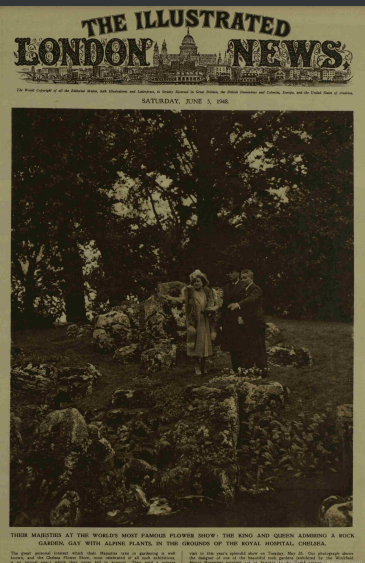
Picture of the King and Queen at RHS Chelsea Flower Show 1948
John Lipscomb also invited the Kent Group to visit his garden on 8th June having viewed the Kent Group Trial Ground at Rowhill Grange, Wilmington.
Although John was still interested in irises and continued to be a member of the Kent Iris Group a rather telling paragraph in the Kent archive book shows where his true passion lay:
‘The renegade Captain Lipscomb, grown tired of trying in vain to capture a Dykes Medal, has turned for solace to ducklings, and leaving his irises to run themselves as best they may alone at Swanley, he deserts them and us for half the year to rear ducklings in Wales instead’
His address in Wales is listed as Garth Duck Farm, Llanafau Fawr, Builth Wells, Brecons.
There continue to be mentions of Captain Lipscomb including that he preferred ‘CLOTH OF GOLD‘ to ‘OLA KALA‘. He felt ‘CLOTH OF GOLD‘ had a longer flowering season.
He made a rare appearance at a meeting and said:
‘I am quite interested in the Show reports, because I cannot go to see them these days, and it does keep me informed of what are now being shown’. Captain Lipscomb also said that he thought the President’s article on perspective planting would interest a large portion of the Members of the Society; others thought one would have to be a bit of a specialist to appreciate it.’
And in 1947
‘At the seedling show on June 7th we had nothing in the way of prizes to offer the winners, but since then Captain Lipscomb had very generously presented us with a silver cup, and this is now being engraved for presentation to Mr Goulton (who won first prize). We are naming this Trophy ‘The Lipscomb Cup’ and it will be presented annually to the raiser of the best seedling in the Kent Group.’
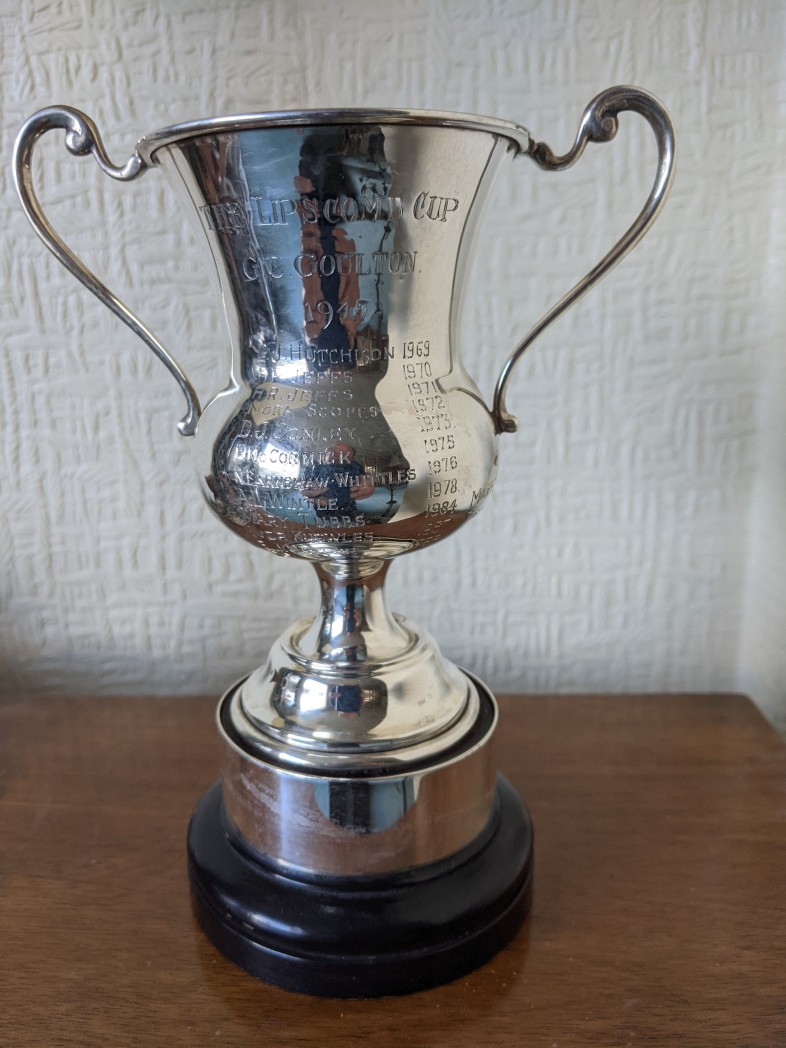
John Lipscomb remained a member of the British Iris Society until he died. A short obituary appeared in the BIS Yearbook in 1978….
‘Towards the end of the war a few interested members of the Iris Society met together to form the Kent Group. One of them was Kenneth Lipscombe (sic) who had already grown irises for some time. His mother had been a member of the Society for several years before the war and was a keen and regular exhibitor at the shows. The first mention of Capt. Lipscombe in the Society’s records was in 1937 when among the irises raised and exhibited by his mother was one named ‘Kenneth’, later registered in 1939. In 1938 he was awarded a Bronze Medal for three seedlings and in 1939 he showed a number of spikes winning another Bronze Medal and the Rainbow Challenge Bowl for most points in Division II. This was his most successful year as a showman, but he continued on a smaller scale for some years when shows started again after the war.
Perhaps he will be best remembered in the Kent Group where he presented the Lipscombe cup for the best seedling shown by a member at the Group’s annual show. His presence at Group meetings always added a dimension, with his quiet, but apposite, and often humorous interjections. To the last he was interested in gardening and irises and he personally presented his Cup to Mrs A Wintle in June this year. He died in August and will be greatly missed by his many friends – a gentleman of the old school.’ HJR
But his iris ‘Duckling’ is very much still with us and so the story of the horticultural Lipscomb family is embodied in this plant.
With special thanks to the Royal Botanic Gardens Kew Library staff.
Frederick Martin Lipscomb
https://history.rcplondon.ac.uk/inspiring-physicians/frederick-martin-lipscomb
https://wellcomecollection.org/works/v4guwz8z
Lancelot Lipscomb
http://www7.bbk.ac.uk/ibamuseum2/resources/photography/kewgardens
https://plants.jstor.org/stable/10.5555/al.ap.visual.kldc12125
